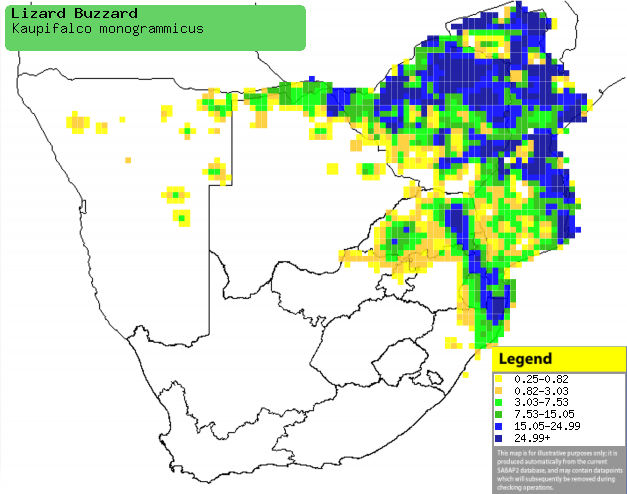|
Kaupifalco monogrammicus
(Lizard buzzard)
Akkedisvalk [Afrikaans]; uKlebe [Zulu]; Rukodzi (generic
name for a small raptor such as falcon or sparrowhawk) [Shona]; Lusotane
[Swazi]; Rikhozi (generic term for some raptors) [Tsonga]; Phakalane,
Segōōtsane (generic terms for some of the smaller raptors) [Tswana];
Hagedisbuizerd [Dutch]; Autour unibande [French]; Sperberbussard [German];
Gavićo-papa-lagartos [Portuguese]
Life
> Eukaryotes >
Opisthokonta
> Metazoa (animals) >
Bilateria >
Deuterostomia > Chordata >
Craniata > Vertebrata (vertebrates) > Gnathostomata (jawed
vertebrates) > Teleostomi (teleost fish) > Osteichthyes (bony fish) > Class:
Sarcopterygii (lobe-finned
fish) > Stegocephalia (terrestrial
vertebrates) > Tetrapoda
(four-legged vertebrates) > Reptiliomorpha > Amniota >
Reptilia (reptiles) >
Romeriida > Diapsida > Archosauromorpha > Archosauria >
Dinosauria
(dinosaurs) > Saurischia > Theropoda (bipedal predatory dinosaurs) >
Coelurosauria > Maniraptora > Aves
(birds) > Order: Falconiformes
> Family: Accipitridae
Distribution and habitat
Occurs in sub-Saharan Africa, in the area from Eritrea to
South Africa. In southern Africa, it is locally common across Zimbabwe,
Mozambique, north-eastern South Africa, northern and eastern Botswana and
north-eastern Namibia. It generally prefers savanna woodland, especially miombo (Brachystegia)
woodland in higher rainfall areas.
|
 |
|
Distribution of Lizard buzzard in southern Africa,
based on statistical smoothing of the records from first SA Bird Atlas
Project (©
Animal Demography unit, University of
Cape Town; smoothing by Birgit Erni and Francesca Little). Colours range
from dark blue (most common) through to yellow (least common).
See here for the latest distribution
from the SABAP2. |
Movements and migrations
Little known, but it is thought be largely
resident and sedentary. There is evidence to suggest that it moves
from moist woodland in summer to more arid savanna in winter; it is
most commonly recorded in north-eastern South Africa in the period
from April-August.
Food
It mainly eats lizards, snakes, frogs and rodents, doing
most of its hunting from a perch over long grass, pouncing on prey on the
ground. Hunting snakes is a risky business, as it sometimes dies in the coils of a
snake it had previously attacked. The following food items have been recorded
in its diet:
- Vertebrates
- reptiles
- frogs
- rodents (Rodentia)
- birds (rarely)
- Invertebrates
Breeding
- Little known in southern Africa, it is thought be a monogamous,
territorial solitary nester.
- The nest is built by both sexes, consisting of a stick platform with a
shallow depression in the centre, which is lined with Old-mans-beard lichen
(Usnea), pine (Pinus) needles and occasionally green leaves.
It is typically placed high up in a tall tree, such as the following:
- indigenous trees
- Mopane (Colosphermum mopane)
- Acacia
- Burkea africana (Burkea)
- alien trees
- Egg-laying season is from May-January, peaking from September-October.
- It lays 1-3 eggs, which are incubated solely by the female for about
32-34 days, while the male regularly provides her with food.
- The chicks leave the nest at about 40 days old, remaining in the same
tree for another four days or so before moving away; they become fully
independent at approximately 90 days old.
Threats
Not threatened, although its population appears to have
seriously decreased since the early 1900s, probably due to destruction of
woodland.
References
-
Hockey PAR, Dean WRJ and Ryan PG 2005. Roberts
- Birds of southern Africa, VIIth ed. The Trustees of the John Voelcker
Bird Book Fund, Cape Town.
|
